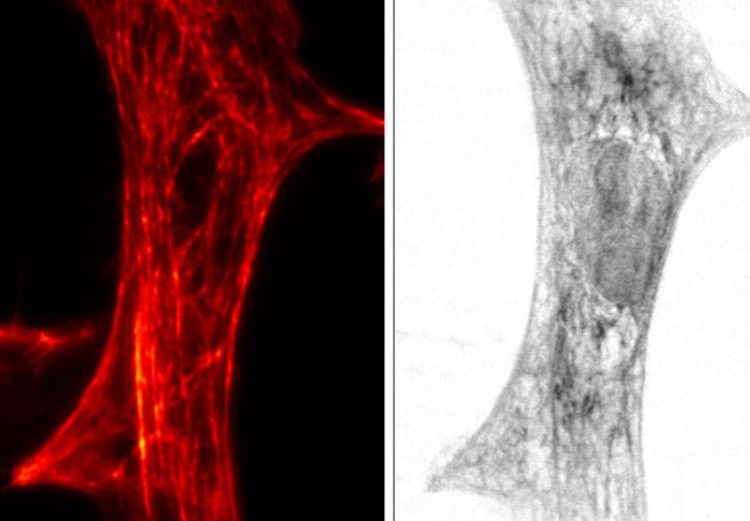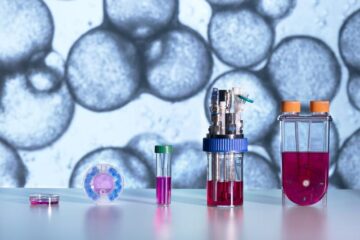Goettingen researchers combine light and X-ray microscopy for comprehensive insights

STED image (left) and x-ray imaging (right) of the same cardiac tissue cell from a rat. University of Goettingen
The team led by Prof. Dr. Tim Salditt and Prof. Dr. Sarah Köster from the Institute of X-Ray Physics “attached” small fluorescent markers to the molecules of interest, for example proteins or DNA.
The controlled switching of the fluorescent dye in the so-called STED (Stimulated Emission Depletion) microscope then enables highest resolution down to a few billionth of a meter.
The Goettingen team combined a light microscope according to the STED principle, which represents the illuminated area of the cell, with an X-ray microscope, which represents the unilluminated area of the cell.
“We used the innovative microscope to show a network of protein filaments in heart muscle cells,” explains Marten Bernhardt, first author of the publication.
“The protein networks contained therein were mapped in STED mode. We were then able to fit these STED images into the X-ray images of the cell. Both recordings are recorded practically directly one after another,” says Bernhardt.
“We hope that the complementary contrasts will provide us with a more complete understanding of the contraction of heart muscle cells and their generation of strength,” adds Salditt.
In designing the STED microscope, the scientists worked closely with the research centre “Deutsches Elektronen-Synchrotron DESY” and the Abberior company founded by Goettingen Nobel Prize winner Prof. Dr. Stefan W. Hell. “In future, we also want to observe dynamic processes in living cells,” concludes Köster.
Prof. Dr. Tim Salditt
Georg-August-Universität Göttingen
Institute for X-Ray Physics
Friedrich-Hund-Platz 1
37077 Göttingen
phone: +49-(0)551-39 9427
email: tsaldit@gwdg.de
M. Bernhardt et al. Correlative microscopy approach for biology using x-ray holography, x-ray scanning diffrac-tion, and STED microscopy. Nature Communications (2018) DOI: 10.1038/s41467-018-05885-z
Media Contact
More Information:
http://www.uni-goettingen.de/All latest news from the category: Physics and Astronomy
This area deals with the fundamental laws and building blocks of nature and how they interact, the properties and the behavior of matter, and research into space and time and their structures.
innovations-report provides in-depth reports and articles on subjects such as astrophysics, laser technologies, nuclear, quantum, particle and solid-state physics, nanotechnologies, planetary research and findings (Mars, Venus) and developments related to the Hubble Telescope.
Newest articles

Web platform and app aim to improve quality of life for people with Parkinson’s disease
Parkinson’s disease is one of the most prevalent neurodegenerative conditions. It causes motor impairments such as tremors, slow movement, muscle stiffness, and balance problems. The individual course of the disease…

Bioreactor research processes and cryotechnologies
… improve active ingredient tests using human cell cultures. Many new drug candidates end up failing because they cause serious side effects in clinical trials. This is a common occurrence…

Systematic testing of natural oils on in vitro skin models
For some years now, the trend in the cosmetics and skincare sector has been toward transparency and natural, sustainable ingredients. A growing number of consumers are rejecting cosmetics that contain…





















